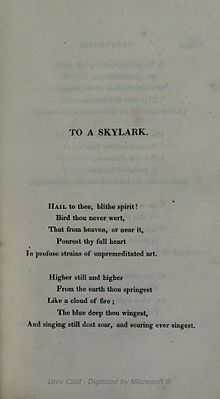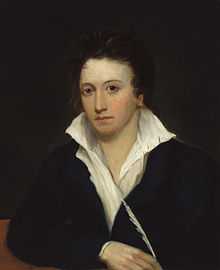To a Skylark



| Wikisource has original text related to this article: |
To a Skylark is a poem completed by Percy Bysshe Shelley in late June 1820 and published accompanying his lyrical drama Prometheus Unbound by Charles and James Collier in London.[1]
It was inspired by an evening walk in the country near Livorno, Italy, with his wife Mary Shelley, and describes the appearance and song of a skylark they come upon.[2] Mary Shelley described the event that inspired Shelley to write "To a Skylark": "In the Spring we spent a week or two near Leghorn (Livorno) ... It was on a beautiful summer evening while wandering among the lanes whose myrtle hedges were the bowers of the fire-flies, that we heard the carolling of the skylark."[3]
Form
The work consists of twenty-one stanzas of five lines each, with all twenty-one following the same pattern. The first four lines are in the meter of trochaic trimeter. The fifth is in iambic hexameter, also known as an Alexandrine. The rhyme scheme of each stanza is in the form ABABB.
Influence
The 1941 comic play Blithe Spirit by Noël Coward takes its title from the opening line:
- "Hail to thee, blithe Spirit! / Bird thou never wert".
Thomas Hardy wrote the poem "Shelley's Skylark".
References
- ↑ Sandy, Mark (21 March 2002). "To a Skylark". The Literary Encyclopedia. Retrieved 2006-01-09.
- ↑ Sandy, Mark (21 March 2002). "To a Skylark". The Literary Encyclopedia. Retrieved 2006-01-09.
- ↑ "Literature Notes - Homework Help - Study Guides - Test Prep - CliffsNotes". Retrieved 23 September 2014.
Sources
- Hunter, Parks, C., Jr. "Undercurrents of Anacreontics in Shelley's 'To a Skylark' and 'The Cloud'. Studies in Philology, Vol. 65, No. 4 (Jul. 1968), pp. 677–692.
- Burt, Mary Elizabrth, ed. Poems That Every Child Should Know. BiblioBazaar, 2009. First published in 1904 in New York by Doubleday, Page & Company.
- Cervo, Nathan. "Hopkins' 'The Caged Skylark' and Shelley's 'To a Skylark.'" Explicator, 47.1(1988): 16–20.
- McClelland, Fleming. "Shelley's 'To a Sky-Lark.'" Explicator, 47.1 (1988): 15–16.
- Mahoney, John L. "Teaching 'To a Sky-Lark' in Relation to Shelley's Defense." Hall, Spencer (ed.). Approaches to Teaching Shelley's Poetry. New York: MLA, 1990. 83–85.
- Lewitt, Philip Jay. "Hidden Voices: Bird-Watching in Shelley, Keats, and Whitman." Kyushu American Literature, 28 (1987): 55–63.
- Ulmer, William A. "Some Hidden Want: Aspiration in 'To a Sky-Lark.'" Studies in Romanticism, 23.2 (1984): 245–58.
- Meihuizen, N. "Birds and Bird-Song in Wordsworth, Shelley and Yeats: The Study of a Relationship between Three Poems." English Studies in Africa, 31.1 (1988): 51–63.
- MacEachen, Dougald B. CliffsNotes on Shelley's Poems. 18 July 2011[1]
- SparkNotes Editors. “SparkNote on Shelley’s Poetry.” SparkNotes.com. SparkNotes LLC. 2002. Web. 11 Jul 2011.
- Behrendt, Stephen C. Shelley and His Audiences. University of Nebraska Press: Lincoln and London, 1989.
- O'Neil, Michael. Percy Bysshe Shelley: A Literary Life. The MacMillan Press, Ltd.: London, 1989.
- Tomalin, Claire. Shelley and His World. Thames and Hudson, Ltd.: London, 1980.
- White, Ivey Newman. Portrait of Shelley. Alfred A. Knopf, Inc.: New York, 1945.
- Zillman, Lawrence John. Shelley's Prometheus Unbound. University of Washington Press: Seattle, 1959.
External links
- Audiorecording of "To a Skylark" read by Kara Shallenberg on LibriVox, track 64, from Poems Every Child Should Know (1904), Mary E. Burt, ed.
- Online version on Bartleby.com.
| |||||||||||||||||||||||||||||||||||||||||
- ↑ "Literature Notes - Homework Help - Study Guides - Test Prep - CliffsNotes". Retrieved 23 September 2014.
